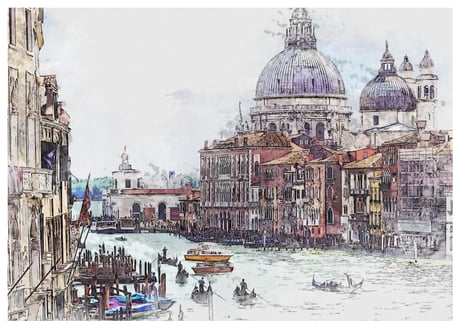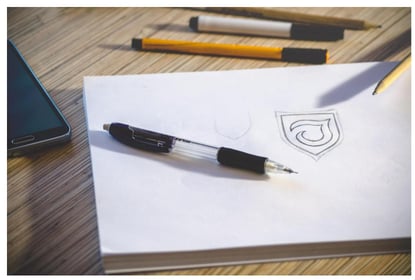
Photo caption: If you’re into travel sketching, you can continue your daily sketchbook habit even when you’re on vacation in exotic locales, like Venice. Image by ArtTower from Pixabay.
If you’re an artist and you don’t have a daily sketchbook habit, you may want to make time for it. It isn’t an exaggeration to say that taking time to draw in your sketchbook each day could increase your artistic abilities exponentially.
That said, many artists have trouble getting started with a consistent daily sketchbook habit, even if they love to draw. Some of this issue has to do with not knowing what to draw, but some of their reluctance also has to do with the "why."
In other words, they really don't know why artists keep sketchbooks, so they find their motivation lacking.
This blog post offers a little help for both of those issues.
Here are five reasons why artists keep sketchbooks.
1. To Hone Their Skills
If you aspire to be a representational artist - as opposed to an abstract artist - then few things will help you improve your skills like drawing from life in your sketchbook. This type of drawing improves your observational skills, as well as your eye-hand coordination.
You'll additionally develop your problem-solving skills when you encounter something new that you’re not used to drawing, like the texture of tree bark.
Aside from this, drawing from life, especially drawing outside, on the regular teaches you how the light changes throughout the day and throughout the seasons. For example, the color and quality of the light at noon during the summer is very different than it is during the winter at the same time of day. If you learn how to capture these seasonal light changes in your sketchbook, you’ll eventually be able to recreate them in your paintings.
The other thing that many beginning artists have trouble with is the 3d-to-2D transition that happens when they draw directly from life. In other words, if you draw from a photograph, the camera already flattens the three-dimensional scene into a two-dimensional scene.
It's not that you can never draw from photos. You certainly can. (We do!) However, when you draw directly from life, your brain instead of the camera has to do the 3D-to-2D translation.
This skill requires practice, but once you master it, your artwork will be so much better. You'll have a better idea of the true colors of items, how long a hallway is or how deep a vaulted ceiling is. This type of drawing also prepares you to draw from your imagination if that's what you want to do.
2. To Practice Using New Materials
Here’s the thing about keeping a sketchbook. Many artists don’t only draw in them with pencils. They will also try out new painting media that they're not used to working with, like watercolor, acrylic or mixed media.
Keeping a daily sketchbook routine allows artists to experiment to see how each different media handles, particularly if they mix different media together. For example, if this is why you've taken up a daily sketchbook habit, you may be interested in mixing acrylics with inks to see how this combination affects the color or the texture.
Trying this in your sketchbook first allows you to make mistakes. Drawing and painting in your sketchbook, unlike making art on canvas, gives you the freedom to learn how new materials handle without also having to worry about “ruining a painting.”
You may also be interested to see which kinds of paper work best with each type of drawing or painting media. It may be that you discover that the paper in one of your sketchbooks works better for mixed media, while the paper in another sketchbook works better with watercolor pencils or even liquid graphite. Sometimes, you won’t know the answer to this question until you’ve experimented a bit.
3. To Keep a Visual Journal of Their Experiences
If you've followed the Milan Art Institute blog for a while, you know that we're big fans of travel and travel sketching. In fact, we’re so addicted to making art on the road, that it's not unusual for any one of us to keep a small separate travel sketchbook just for this purpose.
There is nothing like drawing a place to remind you of the fun you had while you were on your last vacation. Somehow, that little sketch you made of one of the dog statues here in Athens, Georgia with a few pens and some watercolors will mean more to you than taking photos of the same pups.
As author Danny Gregory explains it in his book "An Illustrated Journey," he took up travel sketching, because he didn't want all of his photos of places, like Paris, to look like everyone else's. If that were the case, he argues in his book, he could just buy postcards.
The fact is your brain remembers things differently when you make sketches or drawings of people, places or things rather than taking photos of these same elements, as we pointed out in a recent blog post.
Additionally, if you're into urban sketching, it's likely that you also write comments next to the drawings in your sketchbook. This commentary can include why you noticed what you were drawing and why you decided to draw that particular spot as opposed to another. In this way, your travel sketchbook becomes your own personal newspaper of the daily events you experienced while you were on vacation.
Finally, urban and travel sketching are two of the best ways to satisfy the I-don't-know-what-to-draw issue. If you have scenery in front of you and some art materials, you'll find subject matter for future drawings and paintings just by drawing the places you visit.
To get some more specific ideas, read this blog post about doing some urban sketching during the month of October.
4. To Develop Ideas for Projects
Many professional artists use their daily sketchbook habit to develop ideas for work projects. For example, if you've gone through our Mastery Program, you'll learn how to develop ideas for paintings. Some of the techniques we teach you involve photographic reference materials.
However, the advantage of keeping a sketchbook is that if you suddenly get an idea for a painting, you can make a quick sketch of your idea in your sketchbook to save the idea. This is particularly helpful if your idea includes fantastical elements, like mythical animals, like unicorns or centaurs or professional design elements, like logos.
Later, when you're back in your studio, you can refine the sketch or look for additional photographic references to draw from to further refine your sketch.

Photo caption: An illustrator’s sketchbook might include ideas for company logos, book illustrations or T-shirt designs. Image by tookapic from Pixabay.
5. To Play
If this list gives you the impression that your daily sketchbook habit is only about developing ideas for your work projects or to improve your skills, that certainly isn't the case.
While it is true that drawing in your sketchbook every day will help you out in those areas, those aren't the most important reasons why you might want to draw in your sketchbook on the regular.
Your daily sketchbook habit should include some play, too. If it doesn't, you're probably not doing it right.
In other words, mastering your art skills does take practice and determination, but even the most disciplined approach to art mastery should include space for joy and fun. When you have fun while making art, you lose yourself in the "Zone" and begin to tap into your right brain.
Ironically, this is exactly what you need to improve as an artist. While our programs, like the Mastery Program, teach you plenty of ways to improve your art skills, we also know that fun activities, like drawing just for fun, sometimes bring on the best results where improvement is concerned.
Video caption: A video about starting a sketchbook for some inspiration!
Why Do Artists Keep Sketchbooks - Final Thoughts
As you can see, there are plenty of reasons why artists keep a daily sketchbook routine. In their books, they record their ideas for paintings, try out new art materials and even hone their artistic skills. Still others, love their daily doodles, because these little drawings allow them to add an element of play to their day.
Finally, artists who keep their daily sketchbook habit going even when they travel are better able to remember their vacations. For these artists, it's truly sweet, indeed, when they can look back on their August vacation in Italy during the cold months of January.
It's truly a wondrous experience to be able to look back at life in this way, and sketching every day allows artists to do this. It's for these and other reasons why we encourage you to draw a little in their sketchbooks each day.
Learn More About Becoming an Artist From These Posts
Not Ready for the Mastery Program? Then Try the Beginner Art Program
Art Schools in Georgia: What You Need to Know
How to Become a Professional Artist: Building Your Artist Mailing List

